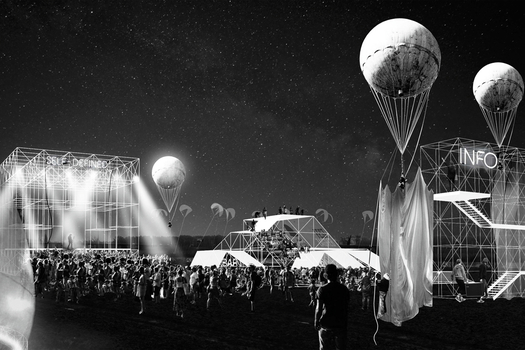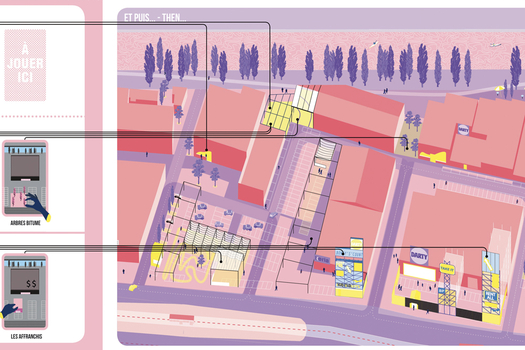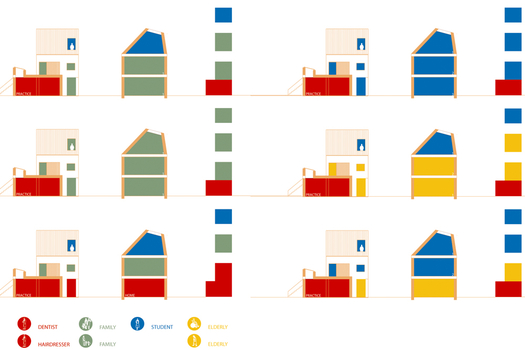THE PROJECT THROUGH THE PRISM OF THE ADAPTABLE CITY
Didier Rebois (FR)
architect, teacher, Europan general secretary, Paris (FR)
The author makes a classification of urban projects following their different strategies to combine a long term vision for the transformation of the contexts with flexible structures adaptable to moving and changing cities.
This article is part of the E13 Results catalogue, published by Europan Europe in June 2016.
THE PROJECT THROUGH THE PRISM OF THE ADAPTABLE CITY
STRATEGIES FOR DEFINING THE 21ST-CENTURY CITY?
A THEME AND THREE SUB-THEMES
This session continued the theme of the Europan 12 competition, The Adaptable City, applying it in new variations. For Europan, it is important that the processes arising from the competition should do more to involve the actors as protagonists of the project, but in different forms. Urban projects need to be able to evolve over time, so the challenge is to conceive them differently. The trick is to be able to combine the long term – a vision for the future that is necessary for the transformation of a context – with a flexible project that proposes spatial solutions and modes of production that can adapt to a city that is moving, changing, dynamic.
How can we escape from the still prevalent rigid functionalism to produce Europe’s cities, while adapting to changes in ways of life and the environment?
Europan uses this thematic as a background to emphasise three sub-themes as questions to the actors and competitors: first, how can the project develop around value as sharing and solidarity?; second, at a time of economic crisis and also of private sector dominance in the production of cities and architecture, how can we devise new ways of organising urban commissions and the actors, that give a greater role to a bottom-up approach? And finally, how can the project concentrate more on the production processes over time than on ready-to-build objects?
SITES AND PEOPLE THAT ARE MOTIVATED, BUT LOOKING FOR PRAGMATIC SOLUTIONS
49 sites located in cities in 15 European countries were selected around this theme. It is noteworthy that despite a severe crisis in the public finances, Europan found active partners with interesting sites. For the urban players, the notion of adaptability is about the compatibility of spaces to urban practices, but also about integrating unpredictable timeframes into the production of urban projects. While the objective of the municipal players is still to obtain a vision for the future of their sites, which can form the basis for political choices and will appeal to their constituents, there is also a realistic need for these projects/visions to be embodied in highly practical implementation proposals.
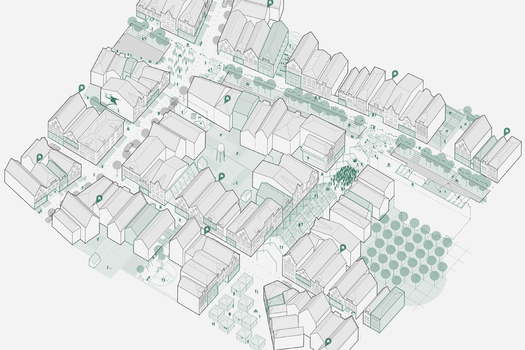
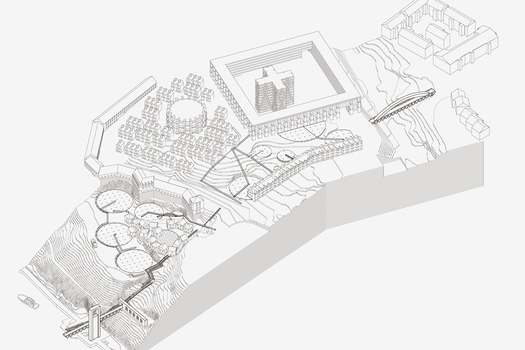
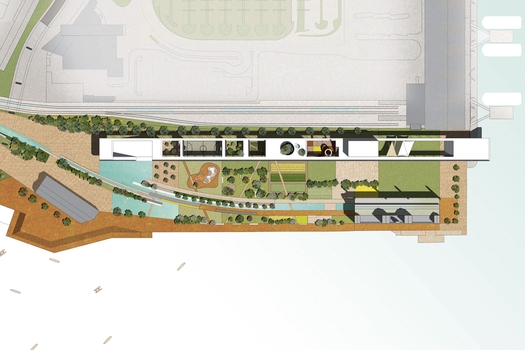
In the catalogue, these sites are presented alongside an interview with a local representative who explains the municipality’s goals.
EXPERIMENTAL PROJECTS PROPOSING A MIX OF REALISM AND INNOVATION
For the competitors, therefore, the task was to carry out the complex exercise of conceiving projects that combine a vision for the future, innovation in the project design process and pragmatism in implementation. Naturally, different interpretations emerge in the responses, but the juries were keen to choose winning teams that were proposing innovative project practices around one main question: how to reconcile the need to define spaces able to adapt to perpetually changing uses and practices?
The winning proposals that this article wishes to explore are those that propose changes in professional practices and challenge the traditional role of the architect. It will draw on the projects themselves, but will also cite the post-competition interviews conducted by Europan Europe with the winning teams about their positions on the question of adaptability and the way it is tackled in their projects.
The project as a lasting urban form that accommodates changing uses
Some of the winning teams argue that urban form and architecture are enduring factors. For them, the challenge is to reuse stable typologies that can adapt to new uses. In some cases, this means harmonising with the existing refurbished urban fabric; in others it means creating new building forms designed to last. Only the uses change with time and the city has a permanent dimension capable of absorbing these changes without its structure and its spaces being affected.
The title of the runner-up project in Leeuwarden (NL), Urban Prescriptions (fig.1), puts its cards on the table. The challenges are to reclaim built-up plots in a historical fabric and to introduce a new program into a former museum site. For the team, this means reconciling respect for the existing qualities and adaptability, i.e. a change in program. The team proposes to reinforce the public spaces in the block through small-scale micro-interventions that will render it adaptable without fundamental alteration. “We believe that the city of the future will not significantly change, it will just be used differently.” In this restored urban structure, the team proposes to convert courtyards into eco-productive areas: water will be returned to the abandoned channels, temporary uses will be proposed for vacant areas and convertible public spaces will be created. However, this intervention leaves open the integration –in the long term– of future uses, which will need to be agreed with residents
This same standpoint is found in teams that are not working on an existing fabric, but on a future new neighbourhood, linked with a perception of the nearby fabric. “The contemporary city is not one but several places. It is a complex structure, multilayered, varied, made up of complementary and interconnected ideas, concepts and systems,” according to the runner-up team on the Nacka site (SE), The Ends of the City (fig.2). “It is time to rethink urban form as a factor of resilience, rather than something futile that demands constant rehabilitation.” On a riverside industrial storage site, the team proposes to build a new urban form, sharply defined by large buildings that form juxtaposed urban signals. However, these big architectures are designed to be flexible and to accommodate to changing uses. For example, the floors can host different functions and the programs can be converted from housing to workplaces. The lasting object-project cannot be separated from the process whereby it is reused.
In Barreiro (PT), with Between the Lines (fig.3), the winning team adopts exactly the same attitude in another architectural style. It compacts lines of buildings that resonate with the landscape as large structural units onsite. These lines are nevertheless “sufficiently flexible to accommodate the needs and desires of the potential users and self-organized initiatives”.
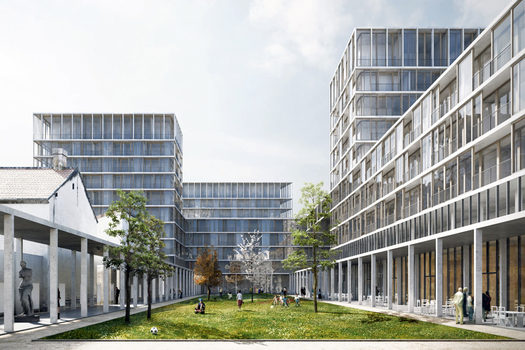
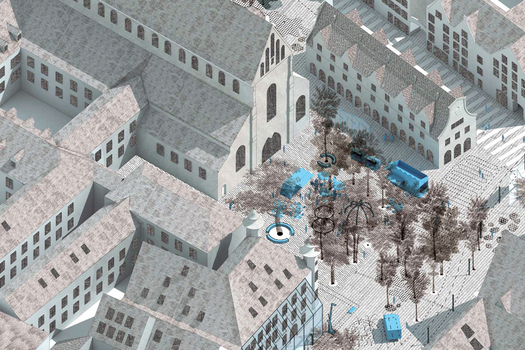
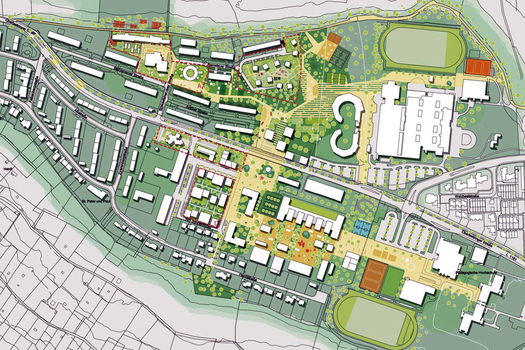
This position is a renewed version of a fairly traditional attitude in the culture of the European city: it had been revived in the 1980s with the return of the city as a matrix around the same slogan – “The city doesn’t change, only uses change.”
The public space project as a framework for construction over time
Other winning teams are also looking for a potentially unifying structure, but exclusively through public space rather than buildings which, in their view, do not follow the same timeframes. For them, the public dimension of the city is what can be defined and controlled over time, whereas buildings – which relate more to the private sphere – are less easy to program and are more arbitrarily embedded in time.
The winning team in Ingolstadt (DE), Waldstrasse (fig.5), clearly states it: the first priority is public space, with the aim of maximising the character of the Northern half of the town. Their idea is that public policies and structures should implement and manage such a program. To this end, the team proposes a series of 5 strategies and 25 initiatives to form the framework for a clearly planned decision-making timetable. From urban-scale parks to interior courtyards, this is a global strategy on public space entailing a non-linear implementation process. It is this strategy that will decide how the construction programs will be realised.
In Schwäbisch Gmünd (DE), the runner-up team with its Creative City (fig.6) project also largely concentrates on public space, noting the lack of pedestrian streets and space that the inhabitants can share in this modern part of the city. The team conducts a close analysis of possible programs to develop new ways of life through specific building interventions (housing, boarding houses, social centres, cultural foundations). However, all these programs will be linked by a participatory public space with citizen involvement, which allows implementation to be spread across different sites and over the long term.
In Molfetta (IT), a city seeking to rehabilitate its seafront, the runner-up team, Molfetta, terra e mare (fig.7), proposes “activity points that can be realised over time...” and it is the outcome of the first operations “that will make it possible to build a promenade as a link”. It will be this public space –an urban promenade reconnecting city and sea– that will act as a backbone to ensure the coherence of an urban space that is at present highly fragmented.
It is interesting to see, in these young teams, such confidence in the existence of an urban public service and political officials capable of sustaining a long-term development project in their use public space as a fairly rapid way to provide urban coherence. This raises the question, jokingly asked by the winning team in Ingolstadt whether: “Wouldn’t this be too much work for the politicians?…”
The ecological project associating the long term of the territory and the short term of the development
The winning project in Moulins (FR), The Theory of Evolution (fig.8), conceptualises this double temporality as they gather reflections from Natural Sciences, through which concepts of Adaptability, Transformation, Evolution, etc. are developed, around one question: “How do living species evolve and guarantee their survival facing modifications of their environments?” If Darwin and Lamarck answer the question in an opposite way, the team nevertheless argues that both doctrines prove to be complementary for the urban project on sites with a higher natural value. The team considers that the reflection on such a site –located around a river with contrasting banks, one urban and the other mainly landscaped– should include the long term of the territory: the slow evolution of the Allier River, bridge lines, floods, dikes and floodplains act as a network of elements structuring the project. Still, faster development linked to “urban economy as well as the values of the parcels and the rents” should not be forgotten. This reflection creates a double temporality implying the association of expertises in terms of project: the one of the landscaper, working on the long-term, topography, hydrography, geology and ground characteristics, and the faster evolution of the city.
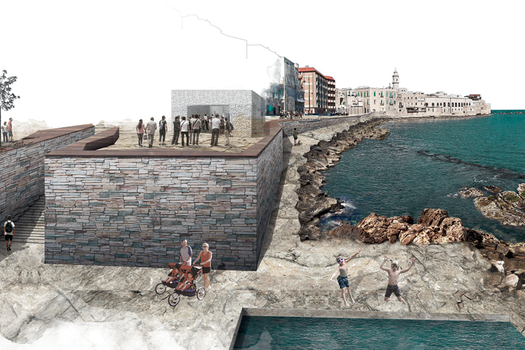
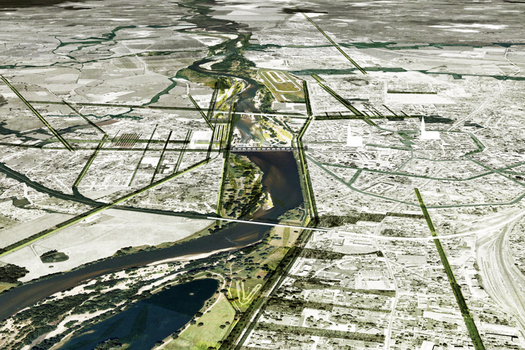
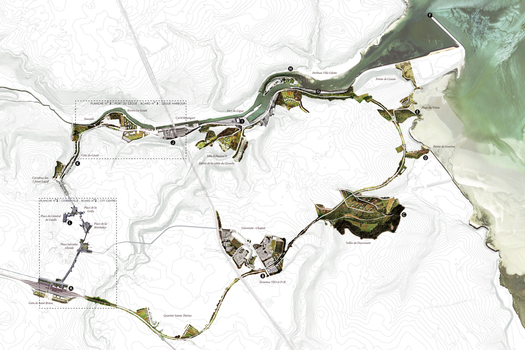
The runner-up project in St Pölten (AT), Ju(MP) in the Water - Kiss That Frog (fig.10), lies as well on the creation of an environmental system through a structure that is defined by water, as a large-scale grid capable of integrating different architectures and programs. It is “a new urban model that develops in time phases and is structured on water lines and basins”, as well as “a new vision of public space that puts everyday life into direct contact with nature”.
Masterplan/project versus acupuncture/project?
Among the teams which believe that public intervention is essential to maintain the long-term coherence of the urban project, a few accept the idea of a masterplan. Nothing reprehensible in that! But the question is how to maintain adherence to a plan that will prescribe urban form and guarantee its implementation piece by piece over time?
In any case, this is the wager of the runner-up team in Selb (DE), Round the Corner (fig.11), which proposes “a systematic approach based on a strong new masterplan…” Working in
a town that has shrunk as a result of industrial decline and is looking to regenerate its central nucleus, the team wants to stabilise the form of a town-centre district through a “process of urban consolidation, by eliminating infrastructural barriers and creating urban places”. However, since the project cannot be implemented in one go, the team proposes that it should start with a regulatory structure and “seek to adapt to opportunities through flexible phasing”. Can the town’s urban planning department stick to this proposal and guarantee to take the project forward over time? In any case, after Europan 9 it had already introduced with the winning team Gutiérrez-delaFuente Arquitectos an acupunctural approach to amenities and housing in the town.
At the opposite extreme from the creation of a masterplan is the Colonization of the City Centre (fig.12) winning project in Gera, another municipality experiencing downgrowth. The team proposes reinforcing a large marginal space in the heart of the town centre, by a process of colonisation based not on a plan, but on an acupunctural approach that revitalises an existing area by injecting new uses. “As the town has a limited budget to invest in urban development, our project’s concept is based on the idea of developing this district sector by sector, in constant collaboration with its residents.” The team proposes beginning with the construction of three buildings, followed by the injection of temporary uses such as container garages, private gardens, play areas, and open-air cinema and a Biergarten (open-air bar), which will occupy the space until more substantial programs can be implemented. It is a tribute to slowness which, around a “starter” urban project, proposes that the next steps should be explored in collaboration with citizens.
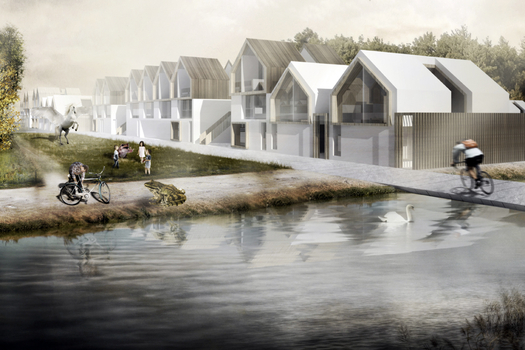
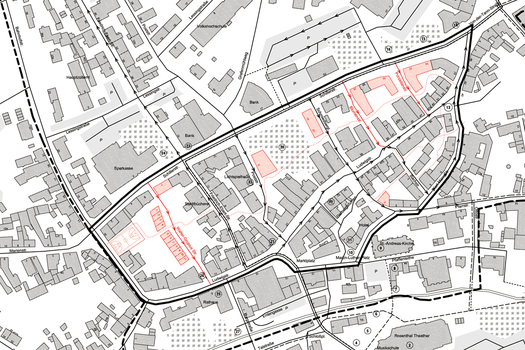
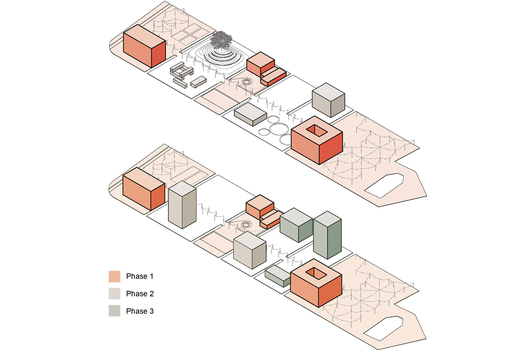
The project that emerges from the existing physical and human fabric
Many teams reject the idea of arbitrarily planning new structures or objects on the sites. They consider that these sites have a history, both in physical space, but also in practices. And they think that the attempt to revitalise these often peripheral areas requires respect for what is already there. For some, therefore, the outline of the project emerges from a meticulous analysis of this existing state.
The runner-up team in Gjakova (KO), Caravanserais (fig.13), is radical in this respect. The diagnosis of a changing urban situation –the riverside areas– accounts for 95% of the conceptual work. This diagnosis, which brings familiarity with the minute details of both spaces and practices, forms the basis of micro-interventions intended to reinforce the urban structure and the identity of the place as a social value.
The runner-up project in A Coruña (ES), Embroidering the Edge (fig.14), proposes a remodelling of the seafront. For the team, the principles of adaptability and self-organization relate to the idea of revealing the values of the place and drawing on them to define a new future. To achieve this, it emphasises the importance of the place, of morphology, of perception and evolution, involving human beings as both inhabitants and makers of their environment. The goal, as Cedric Price called for in architecture, is prevention rather than cure.
In Barcelona (ES), the runner-up project, Sustainable Interface (fig.15), as a follow-on from the same team’s earlier Europan 12 winning project, begins with a meticulous study of the site with the aim of detecting the possibilities of introducing flexibility of uses over time and maintaining a reversibility that will allow the site to return to its original state. Their goal is to introduce into the existing fabric production spaces and activities that are compatible with housing. They devise typologies capable of accommodating such a mix: “active plinths” (productive and commercial spaces) that sustain “lively emergences” (housing, offices, hotels).
Finally, the runner-up project in Charleroi (BE), Making Room for Gilly (fig.16), starts with the layered urban structure of this slightly obsolete district as an opportunity to develop flexible buildings capable of defining public space. With this gradual process, anchored in the existing fabric, the project aims to transform the site over time, in keeping with its users’ needs.
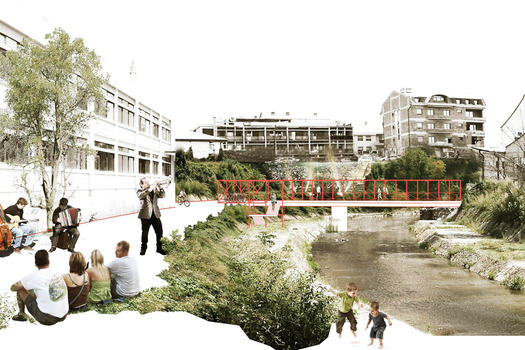
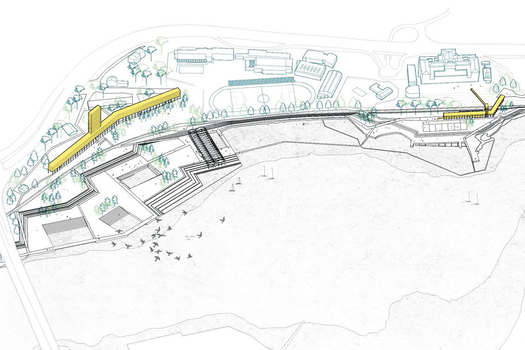
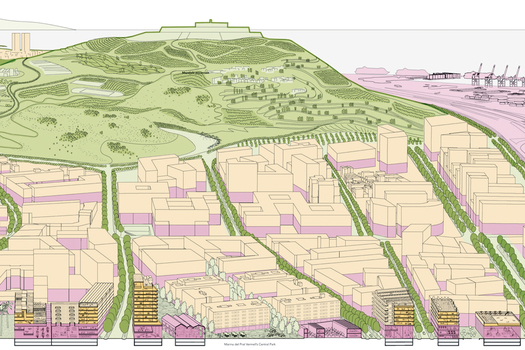
The project as a flexible strategy, adaptable to varying uses
Some winning teams refuse to predefine a global physical structure capable of accommodating flexible uses, because they think that these forms can no longer accommodate to changes in the city. They prefer to propose a flexible strategy, as a system that would itself be able to adapt to changing uses.
Typical of this attitude is the winning team in Barcelona (ES), In Motion (fig.17), which takes the view that the adaptable city requires strategies for constructions where “the built fabric is no longer a fixed element, but a group of heterogeneous elements with different degrees of change”. On an industrial site slated for conversion, they see the priority as being able to accommodate to movement by introducing new strategies that combine adaptability, self-sufficient systems, an eco-systemic perspective and a social approach to housing. The architecture itself must be able to adjust rapidly to keep pace with changing uses.
In Santo Tirso (PT), the runner-up team, 3tirsolines (fig.18), proposes a project that is able to adapt to the needs of the local population by creating a flexible strategy around 3 lines: a connective green axis; a renovated market that becomes public space; increased building density to encourage the influx of new inhabitants and activities. Their project is not a finished form, but a strategy based around principles and that must be capable of adapting to real needs at any time. It is conceived more as a “system of working that involves several urban agents choosing between different activities and actions”.
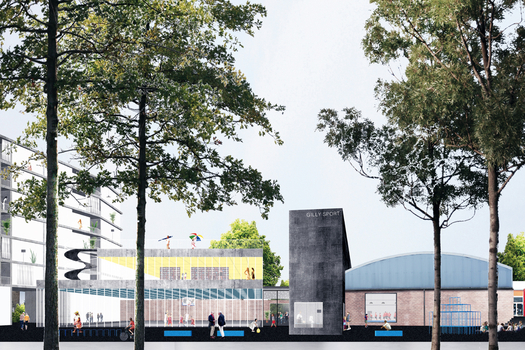
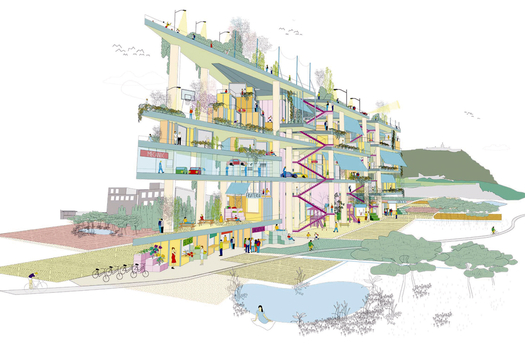
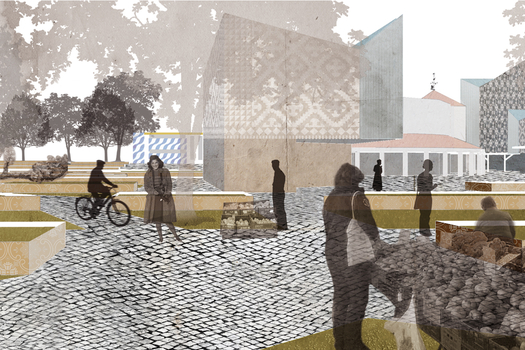
The process-project: negotiated uses and actor interactions
Some teams, adopting a similar attitude also based on flexible strategies, assume the role of tacticians, making the project a nexus of actor interactions and negotiated uses. The project is less formalised, the vision of the future no doubt less defined, but the project is permanently negotiated around responses to change and precise urban goals, without the precise outcome of the process necessarily being known in advance.
For example, Bondy’s Count (fig.20), the winning project in Bondy (FR), is conceived around actions that invite the local economic actors and users to play a role in the site’s transformation. This site, well positioned along the Canal de l’Ourcq on the way out of Paris, is at present essentially an area of commercial activities and the brief is to make it compatible with business and residential activities. To achieve this, partial rearrangements of the plot structures have to be negotiated with the economic players, so that new uses can be introduced while still improving the commercial dynamic. “We consider the process-project as a set of negotiations in which, in the long term, investors, city dwellers and residents are the future protagonists.”
Finally, the runner-up project in Trondheim (NO), More Trondheim! (fig.21), takes the same approach in its plan to revitalise a still functioning brewery by adding other programs based around public activities and leisure. For them, the theme of adaptability reflects the needs of the site: “Working with strategies that are both programmatic and spatial and can develop over time, rather than proposing a finished masterplan.” And it is these well-defined strategies which “form a solid framework that will enable different things to take shape, depending on increases in prices and mortgage rates, demographic segregation and economic groups”.
